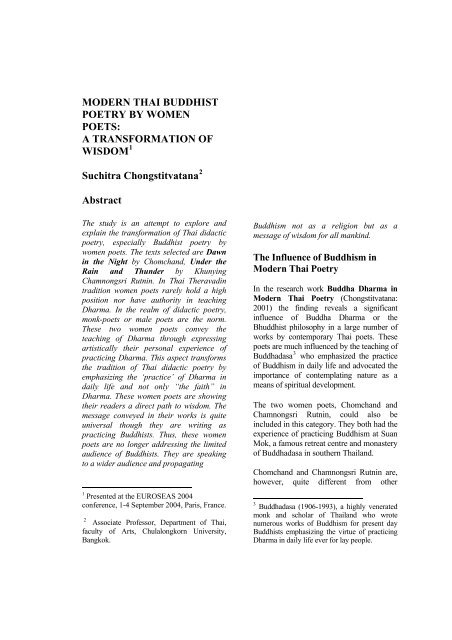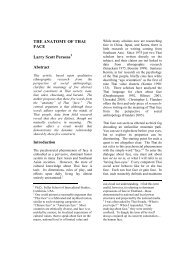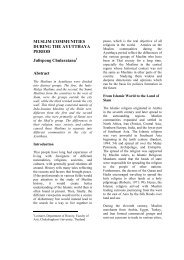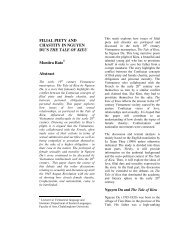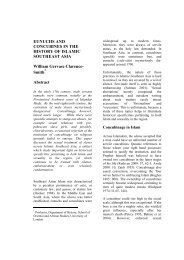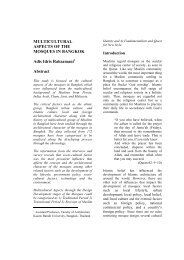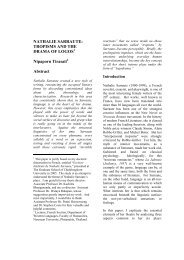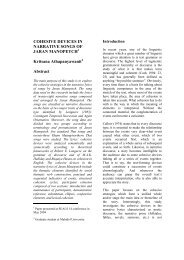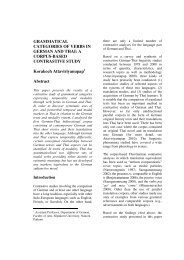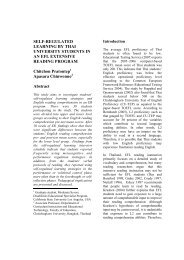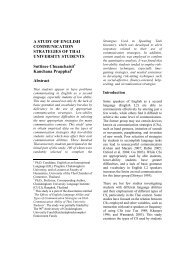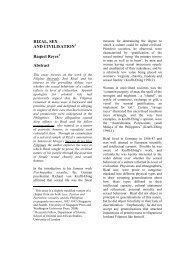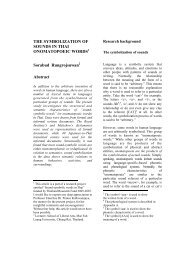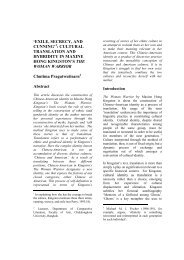Modern Thai Buddhist Poetry by Women Poets: - Manusya :: Journal ...
Modern Thai Buddhist Poetry by Women Poets: - Manusya :: Journal ...
Modern Thai Buddhist Poetry by Women Poets: - Manusya :: Journal ...
You also want an ePaper? Increase the reach of your titles
YUMPU automatically turns print PDFs into web optimized ePapers that Google loves.
MODERN THAI BUDDHISTPOETRY BY WOMENPOETS:A TRANSFORMATION OFWISDOM 1Suchitra Chongstitvatana 2AbstractThe study is an attempt to explore andexplain the transformation of <strong>Thai</strong> didacticpoetry, especially <strong>Buddhist</strong> poetry <strong>by</strong>women poets. The texts selected are Dawnin the Night <strong>by</strong> Chomchand, Under theRain and Thunder <strong>by</strong> KhunyingChamnongsri Rutnin. In <strong>Thai</strong> Theravadintradition women poets rarely hold a highposition nor have authority in teachingDharma. In the realm of didactic poetry,monk-poets or male poets are the norm.These two women poets convey theteaching of Dharma through expressingartistically their personal experience ofpracticing Dharma. This aspect transformsthe tradition of <strong>Thai</strong> didactic poetry <strong>by</strong>emphasizing the ‘practice’ of Dharma indaily life and not only “the faith” inDharma. These women poets are showingtheir readers a direct path to wisdom. Themessage conveyed in their works is quiteuniversal though they are writing aspracticing <strong>Buddhist</strong>s. Thus, these womenpoets are no longer addressing the limitedaudience of <strong>Buddhist</strong>s. They are speakingto a wider audience and propagating1 Presented at the EUROSEAS 2004conference, 1-4 September 2004, Paris, France.2Associate Professor, Department of <strong>Thai</strong>,faculty of Arts, Chulalongkorn University,Bangkok.Buddhism not as a religion but as amessage of wisdom for all mankind.The Influence of Buddhism in<strong>Modern</strong> <strong>Thai</strong> <strong>Poetry</strong>In the research work Buddha Dharma in<strong>Modern</strong> <strong>Thai</strong> <strong>Poetry</strong> (Chongstitvatana:2001) the finding reveals a significantinfluence of Buddha Dharma or theBhuddhist philosophy in a large number ofworks <strong>by</strong> contemporary <strong>Thai</strong> poets. Thesepoets are much influenced <strong>by</strong> the teaching ofBuddhadasa 3 who emphasized the practiceof Buddhism in daily life and advocated theimportance of contemplating nature as ameans of spiritual development.The two women poets, Chomchand andChamnongsri Rutnin, could also beincluded in this category. They both had theexperience of practicing Buddhism at SuanMok, a famous retreat centre and monasteryof Buddhadasa in southern <strong>Thai</strong>land.Chomchand and Chamnongsri Rutnin are,however, quite different from other3 Buddhadasa (1906-1993), a highly veneratedmonk and scholar of <strong>Thai</strong>land who wrotenumerous works of Buddhism for present day<strong>Buddhist</strong>s emphasizing the virtue of practicingDharma in daily life ever for lay people.
<strong>Modern</strong> <strong>Thai</strong> <strong>Buddhist</strong> <strong>Poetry</strong> By <strong>Women</strong> <strong>Poets</strong>contemporary poets. They are not poetswho normally write didactic poetry nor arethey ‘professional’ poets with a largenumber of works.Chomchand is a famous literary critic and avery prolific novelist. Dawn in the Night isher first book of poetry. ChamnongsriRutnin is a well known literary translatorand a playwright. She mostly composesprose poetry and tales rather thanconventional poetry. Under the Rain andThunder is a record of her retreat in theforest monastery of Suan Mok.Both of them are modern poets who writeto ‘convey’ their ideas, feelings andexperiences. Even though their ‘message’ isa message of Buddha Dharma, they do nottry particularly to follow the convention of<strong>Buddhist</strong> poetry of the past. Most <strong>Thai</strong><strong>Buddhist</strong> poets would compose poetry torelate Jataka tales in order to express boththeir faith in the Buddha and their ultimatepurpose of accumulating merit throughspreading the Dharma for the benefits ofall sentient beings.These two women poets are apparentlytrying to share their experience of studyingand practicing Dharma. They mostly relatetheir feelings and contemplation regardingthe nature of the mind and how to developmindfulness leading finally to wisdom.In order to understand how the two poetstransform the wisdom they convey in theirworks, we have to first look at the natureand the significance of their poetry as<strong>Buddhist</strong> poetry.Dawn in the Night: A Birth ofWisdomSix poems have been selected from Dawnin the Night <strong>by</strong> Chomchand. They appeargood representations of Chomchand’s<strong>Buddhist</strong> poetry because their contents areprimarily about how to gain wisdomthrough spiritual practice of contemplationon life and meditation.The name of Chomchand’s book Dawn inthe Night is obviously an exquisitemetaphor for the birth of wisdom.‘Dawn’ signifies light or wisdom, whereas‘Night’ signifies darkness or in a very<strong>Buddhist</strong>ic meaning, ignorance. ‘Dawn inthe Night’ could therefore mean ‘the birthof wisdom out of ignorance’.As a whole, the book contains poemsrelating a fine contemplation of life on thepoet’s part.The first poem selected here shows how thepoet sees ‘worldly’ life as a cruel burden,impossible to get rid of just because of ourown ignorance.Carrying a YokeHow heavy is this yoke!The shoulder can no longer bear itHow long has this been?Far too long for a happy man!Why grumble and complain?Why get angry with this Ugly World?Why complain of bad karma?Why suffer so much for so long?I pay respect to the BuddhaPlease relieve all my painsI’ve suffered tremendous painsThey are burning my heart to death!The Buddha Image smiles and staresHow many heaps of sufferings are there?How many worlds you own?Why complain, just let go!39
MANUSYA: <strong>Journal</strong> of Humanities 8.1, 2005Put them down monkey-humanWith your own hand, put down the yokeThey are under your controlThe yoke is your own choice!ChomchandDawn in the Night 4The concept of ‘life’ or the five aggregatesas a ‘heavy’ thing is apparent in many<strong>Buddhist</strong> texts. So it is not surprising herethat the poet expresses this idea through ametaphor of a yoke or carrying a heavything.The poet also links this concept to thepopular belief of ‘bad karma’ of the past asthe cause of suffering in the present life.However, the real message the poet wouldlike to convey is that according to thegenuine teaching of the Buddha oursuffering in life is mostly a result of ourown attachment and craving. Thus, themention of the Buddha and the advice of‘letting go.’ Also, the poet emphasizes thepower of one’s wisdom to control one’s life.The poet explicitly says that the sufferingsare ‘under your control’ and the carrying ofa yoke is in fact ‘your own choice’.Through this explicit message, the poet isrendering a ‘higher’ teaching to her audiencerather than a conventional teaching of askinga blessing from the Buddha and acceptingthe bad karma of the past because there is noremedy for it.By stating the ultimate truth of ‘letting go’as a genuine solution for a happier life inthis world the poet is pointing to a directpath of wisdom.4 All the poetry in this paper is translated <strong>by</strong>Suchitra ChongstitvatanaThis direct path of wisdom will bebeneficial to present life because it awakesus to the reality of life and cultivates anunderstanding that could further develop toa higher level of enlightenment.The value of self-contemplation, as well ascontemplation of nature, is muchemphasized in <strong>Buddhist</strong> tradition. Thefollowing poem ‘A Revelation’ is a goodexample of self-contemplation <strong>by</strong> the poetwho represents ordinary human beings whostruggle with their own ego and conscienceto be virtuous amidst the complexity of life.A RevelationI used to believe in human potentialIn the right to choose their pathIn the power of their intellectIn the undefeatable abilities!They are perfectly ableTo achieve everythingWhen protected <strong>by</strong> awarenessAnd wisdom of a perfect being!Yet life is not at all easyForwarding too far can become detouringYet cautiously, modestly backwardingYou become a defeated coward!When persisting with courageThen appearing crazily aggressiveWhen trying to be moderateYou appear staying still!Things come to you from nowhereThings get involved without reasonSomething very wicked and maliciousInfluencing sudden mistakes!It is beyond acceptance of defeatIt is beyond any control of changesIt is beyond any fighting back40
<strong>Modern</strong> <strong>Thai</strong> <strong>Buddhist</strong> <strong>Poetry</strong> By <strong>Women</strong> <strong>Poets</strong>Just looking in amazement!This is a revelation!We are just tiny, so absolutely dust!Worldly sins conquer the worldWorldly sins devour our whole life!ChomchandDawn in the NightThe poem starts with the confident tone of ayoung poet who expresses a belief in thepower of human potential in achieving theultimate goal of life.The latter part of the whole poem conveysthe feeling of amazement to the point ofdespair when one grows older and is, moreor less, forced to accept the limitation ofone’s life and circumstances. One has tocome to terms with life as it is and to acceptthat one does not have an ‘absolute’ controlof one’s life.The last two stanzas are quite significant asthey secretly express the ‘weakness’ of thepoet with whom the readers can readilyidentify themselves. They sympathize thepoet and share the same despair andamazement. The poet is not superior to herreaders, for they share the same fate. Thuswhen the poet comes to the conclusion as a‘revelation’ that we are all absolutely asinsignificant as dust, the readers could notbut agree.At this point the poet can convey a ‘realmessage’, that ‘worldly sins conquer theworld and devour our whole life’.Nevertheless, this message is not meant tobe a declaration of truth that one shouldaccept without reacting to it. If the readersrealize this, they must or should dosomething about it. This is the impactintended <strong>by</strong> the poet, as we can easily seefrom the title of the poem ‘a revelation’.The revelation of the complexity of life andthe ‘weakness’ of human nature shouldserve as a good introduction to a seriousspiritual life.The practice of a spiritual life can start witha simple practice of observing nature andobserving one’s own mind. The next poemof Chomchand ‘Voices of the Night’ relatessuch an experience of ‘listening’ to natureand one’s inner voices.Voices of the Night…Softly smoothly the voice echoesThe leaves are falling to sleepHush! Listen to the earthFading, aching petals are dyingCrying heart-rendering tears!Young pure petals are blossomingListen to their joyous melodies!What magic of divine NatureThe radiant world is descending!The voices of the World are magicalClose your eyes, savouring the Divine!Whose sobbing is thatEchoing in the quiet night?Coming and going… so far awayWhispering of the Night!Listen whose heart is crying?Listen what screaming noiseListen what joyous laughingWhere are they all from?Now come, listen againListen to myriads of new voicesThe night and the World is passing usMy heart is making noisesMostly I listen to surrounding peopleMostly I try to give answersMostly I enjoy hearing othersYet never listen to my inner voices!41
MANUSYA: <strong>Journal</strong> of Humanities 8.1, 2005ChomchandDawn in the NightThe first two stanzas are description of acharming night when life and death innature are in harmony. This creates ‘magic’and serene ‘divinity’ of the quiet night.Then come the next two stanzas where theserenity is destroyed <strong>by</strong> suffering and joy –the ‘sobbing’, ‘crying’, ‘screaming’ andlaughing. The serenity of the night isequally destroyed <strong>by</strong> the inner voices of thepoet.The poet ends her poem with an elegantparadox that reveals the truth of many otherpeople. Mostly we listen and try our best tocommunicate with others. We hardly try ormake any special effort to listen to our own‘inner’ voices or the expression of our trueself inside!Here, the poet seems to be mockingeveryone including herself for being soignorant! Listening to one’s self is aprimary requirement for practicing selfobservation or meditation.Therefore, we are able to infer that poet istrying to persuade us to start observing ourselves and our mind <strong>by</strong> starting to listen toour own inner voices.Of course, the practice to Dharma does notstop at listening to the inner voices. Thepoet expresses an explicit manner ofmeditation <strong>by</strong> observing the whole body inthe following poem ‘To Fill a Life’.To Fill a LifeContemplate each part of lifeNow so stained and dirtyHand prints, foot prints all overAnd a big bucket of tears!Contemplate the hidden heartWhy so empty nowWith cuts and untidy lines,Holes and holes all over!Contemplate the brainThe membrane sadly decaysMemories and intelligence fadingFlowing away despite perfect knowingContemplate the whole mutilated bodyThe speaking mouth is full of wormsThe seeing eyes are in fact blindThe hearing ears are in fact deaf!The nose is not functioningThe hand is not writingThe legs are not properly walkingHow all the body is deteriorating!Now I’ll fill you to perfectionWith smiling heart and willing bodyFollowing the flow of wisdomIns and outs of the serene breath!ChomchandDawn in the NightIn <strong>Buddhist</strong> tradition, an analyticalcontemplation of each part of the body asunpleasant and undesirable is a commontechnique of meditation. This method isemployed as a means to get rid of one’sclinging to one’s body and also theignorant attachment to the body as ‘self’.Therefore, the poet adapts this attitude inher contemplation of the body. So we canperceive the ‘deteriorating’ process inevery part of the body apart from the factthat it is badly damaged <strong>by</strong> life itself!The important message is the last stanza,where the poet declares that the practice ofmeditation on the in - and out - breath is theperfect cure for a damaged life or body.What the poet is saying in fact reflects bothworldly and otherworldly aspects of42
<strong>Modern</strong> <strong>Thai</strong> <strong>Buddhist</strong> <strong>Poetry</strong> By <strong>Women</strong> <strong>Poets</strong>meditation. On the worldly level, breathingmeditation is an efficient means to gainserenity of mind and thus renders an ideallife of happiness according to <strong>Buddhist</strong>belief.On the otherworldly level, meditation is themost efficient way to gain wisdom.Through this spiritual wisdom one can hopeto attain Nirvana. To attain Nirvana meansthat one puts an end to Samsara or the cycleof repeated birth and death. So when onegets out of Samsara one does not have tosuffer the ‘deteriorating’ process of thebody or life any longer.In the poem ‘Candle Light’, the beauty andserenity of meditation are artisticallyconveyed.Candle LightSoftly softly shiningSoftly softly movingSwiftly close your eyesSwiftly Swiftly disappearingNow open your eyesThe light is still softly shiningSmilingly close your eyesThe light is swiftly disappearing!Whose candle is this?Linking the thread of dreamsSoftly Softly moving!Now appearing, then disappearingNow the heart, then the candleAppearing and disappearingComing and goingThen a blaze of Light!Softly shining, softly shiningOh heart of illusions!Swiftly disappearingSwiftly blazing!Whose candle is thisLinking the heart threadSoftly and softly movingA blaze of lightSo eye-opening!ChomchandDawn in the NightThe poem expresses the joyous experienceof meditation through the metaphor of thecandle light. It is not clear whether thecandle light here refers to a real thing or thelight in the mind of the meditation or both.Still the serenity of the experience is alluringenough for the readers to be attracted and notto be put off <strong>by</strong> it. (Because there exist somemyth about the danger of meditation withoutan experienced teacher!)The poet’s wish to encourage people topractice meditation is further elaborated inthe poem ‘Golden Boat II’.Golden Boat IICome on board a crescent moon boatCome bravely into this boat for a journeyCome enjoy the radiantly golden boatCome savour the joy of Night!This is not serene and calm peaceThis is not a release of all painThis is not a vibrant joyThis is not an easy escape!Every suffering is still hereEvery suffering is still strong and greatYet it is calmly acknowledged insideHow it happens and goes onThe dawn is approaching the skyThe golden boat seems to be leavingYet in the heart of joyful nightThe golden boat is shining bright!Come on board a crescent moon boatCome down bravely… for a new startCome to greet the brilliant mornCome on a boat journey for a golden path!43
MANUSYA: <strong>Journal</strong> of Humanities 8.1, 2005ChomchandDawn in the NightThe ‘golden boat’ here is a ratherconventional metaphor in <strong>Buddhist</strong> context.The practice of Dharma or the meritsaccumulated are usually compared to a boator a vehicle that could take one across theocean of ‘samsara’. So, here the poet isalluding to this well known metaphor toencourage her readers to board on the‘golden boat’ so that they can start ajourney on the ‘golden Path’ or the path toenlightenment.We have seen how Chomchand advocatesthe practice of Dharma in daily lifeespecially through self contemplation andmeditation.We would now turn to the poems ofChamnongsri Rutnin to see whether sheshares the same opinion as Chomchand.Since they are both, more of less, studentsof Buddhadasa Bhikkhu, it will not besurprising if there are a few similarities inthe ‘message’ in their poetry.The most striking similarity is in theimportance of observing nature in daily lifeas a teacher of Dharma. This aspect is aprominent ‘signature’ of all the followers ofSuan Mok monastery of BuddhadasaBhikkhu.Under the Rain and Thunder: AnAttempt to Go BeyondUnder the Rain and Thunder is in fact adiary in poetry form of the poet when shewas in a long retreat at Suan MokMonastery. This explains why the contentof the work has a prominent harmony ofDharma reflection throughout.The title of the book is a parallel to a<strong>Buddhist</strong> riddle explaining the the state ofmind of an enlightened person who will notbe disturbed <strong>by</strong> any perception nor any joyor suffering. In <strong>Thai</strong> the riddle is ‘Fon TokMai Tong Fa Rong Mai Thung’ , meaning‘untouched <strong>by</strong> the rain and the thunder’.But Chamnongsri Rutnin is saying that‘Fon Tok Yang Tong Fa Rong Yang Thung’means ‘still moved <strong>by</strong> the rain and thethunder’.This title shows that the poet is not claimingthat she has achieved anything special in herpractice or training of Dharma in her retreat.Yet this poetic record is an evidence of anattempt to go beyond, to reach the state ofserenity that is not under the rain and thethunder of life any longer.The first poem selected here illustrates theimportance of contemplation of nature inthe practice of Dharma.A PondMorning LightThe Pond looks radiantCalmClearNo it is not soThis is deceivingIf it is really clear and calmWe must see the bottom!Now we only see the surfaceThe shadows of images and coloursFrom everything reflectedSo clear so very realNo it isn’tIt is not real!Look carefully,The colours in those high treesTheir shadows are different with mossLook carefully,44
<strong>Modern</strong> <strong>Thai</strong> <strong>Buddhist</strong> <strong>Poetry</strong> By <strong>Women</strong> <strong>Poets</strong>The colour of the skyWater illusions, the blue is more intenseThe water clouds spreading like silkIf you look really carefullyYou’ll see the differenceThey are dancing on the ripples!The pond looks radiantAfter the heavy rain last nightSo does the heart!The mind is like the clear waterThat shows all reflectionsDeceiving reflectionsRepeatedly luring the heart!Today the ripples are still alluringThe charm of movementsNever staying stillJust like everything in lifeDragging the heart aroundForgetting to see deep down!Be tranquilLook deep down to the bottomAt least you’ll realizeThe deeper the waterThe more stillMuch clearerAnd much more serene!Chamnongsri RutninUnder the Rain and ThunderThe poem ‘A Pond’ illustrates how onecould meditate on the beauty of nature andreach a deeper understanding of life.The poet warns her readers against the‘alluring’ power of beauty that can obstructthe power of wisdom. However, throughthe merit of mindfulness, one can reachserenity and attain true wisdom. Thus, theadvice of the poet ‘Be tranquil, look deepdown to the bottom.’When one contemplates nature, one alsolooks at other lives in nature. The nextpoem ‘Black Ants’ illustrates the lesson ofwisdom through observing the lives ofblack ants.Black AntsYesterday millions of black antsMigrate like bursting of a black streamAt dawn the stream looks so fierceAfternoon it is still strongAt dusk on the meditation pathThe stream becomes so tinyWinding like a dry water wayFrom where, to where who knowsAmong the millions,How many know their destinationJust following othersWhere does that end, they don’t knowTired, exhausted, so seriousNever ask questionsJust pushing forwardWith all their mightMay be just a very fewKnow their destination!Chamnongsri RutninUnder the Rain and ThunderThe behaviour of black ants inspires aquestion in the poet’s mind, a question of thereal purpose of life. The black ants areobviously compared to us – ordinary humanbeings who are ignorantly following ‘theways of the World’ without questioning.The poet equally uses her contemplation onnature in observing the beautiful butterfliesin nature as a symbol of illusion in a poem‘Butterfly Illusion’.Butterfly IllusionsCatch your thought when moved45
MANUSYA: <strong>Journal</strong> of Humanities 8.1, 2005Like catching a butterflyHold it tight in your fistOnce you open your fist to see the colourNothing is thereOne minute, and the butterflyDancing again in the air!Watch the emotion in your heart movingLove, anger, sorrow, joyStare at it hard, it vanishesStable, still as long as watchedOne minute off guardThe mind moves with the thoughtYou know that thoughts are illusionsComing, going, changing ceaselessly!Various colours, rhythms and melodiesThe wings can never be fixed!Who would tell usHow to teach our childrenNot to be lured <strong>by</strong> butterfliesHundreds and thousands flying from theirheartHow to catch the butterflyDancing amidst their heartCatch it again and againTo clear ignoranceTo purify the mindNot to be precariously movedBy the wings of hundredsAnd thousands of butterflies!Chamnongsri RutninUnder the Rain and ThunderThe metaphor of ‘butterfly’ as a thought orillusion created in our own minds is a veryappropriate one. Butterflies are mostly quitefragile, alluring and short-lived. Ourthoughts and emotions also show thesequalities.The message of the poet at the last stanza isa real encouragement for all of us, childrenand adults to practice mindfulness – tocatch the butterflies dancing in our minds –in order to clear ignorance and to purify themind.Still, in order to ‘purify’ the mind and getrid of ‘ignorance’, we also have tounderstand all our emotions, positive andnegative emotions.The poet explores the nature of variousemotions such as loneliness and fear.The next poem, ‘Loneliness’, is an analysisof the nature of loneliness and how toconquer it in a <strong>Buddhist</strong>ic way.LonelinessFeeling lonely… similar to feeling boredGrowing from a craving heartWishing to run away from oneselfWishing to have someone nearWishing to have someone who understandsThe heart reaching outSearching, lamenting!The remedy is similar to the remedy of boredomLook deep inside yourselfConcentrate on the heart, watch your mindLook deep down, very deep downWe perfectly realizeThat loneliness is much harderTo conquer than boredomFor it has self-pity as its allySelf-pity looms large in the hole insideThe hidden hole so secretly keptLook deep down,Sharply stare at itOnce clearly seen, it dies!Chamnongsri RutninUnder the Rain and ThunderThe poet clearly states that to meditate onloneliness – to look deep down and observe46
<strong>Modern</strong> <strong>Thai</strong> <strong>Buddhist</strong> <strong>Poetry</strong> By <strong>Women</strong> <strong>Poets</strong>it – is the best way to understand it and getrid of it.When it comes to fear, the poet analysizesit in more detail and finds the same solutionin conquering another negative emotion.FearFear has various formsPeople cheat out of fearFear of pain, death, dishonourFear of lacking, loneliness, losingFear ceaselessly governs their heartMoney is a chain binding menMoney is a magic forcing peopleTo accept being ruledKeeping people busy gathering moneySuch is a vicious circleEnlarging the cause of fearHow pitiful!This pity causes forgivenessStill, even pity is hindered <strong>by</strong> fearFear of losing, lackingSo the heart can’t afford forgiveness!Hidden fear must be seriously controlledMust be hunted down!The inner book must be readMinutely read even between the linesFear then creates greedFear again aggravates angerFear makes the heart drunkThe ego is so insecureFear of being destroyedFirst we must manage this FearYour mindfulness will do!Mindfulness and concentration!Chamnongsri RutninUnder the Rain and ThunderThe poem begins with an analysis of fear ina most understanding tone. To understandthat fear creates a lot of suffering such asgreed and anger would certainly make usmerciful to those we consider wicked. Thus,understanding fear will enable us to forgivemore easily.Yet, the poet explores in another poem thecomplication of forgiveness and the dangerof ‘false’ forgiveness.ForgivenessTo ForgiveIs such a tough giving!Especially important thingsComplicate thingsSilly things are easily forgiven!So easy we believe all is the sameBut we must forgiveTo purify our dark heart!Yes, we know that forgivenessGives new lifeFor what could be more terribleThan an angrily burning heartWe just realizeReason and thought can’t make usTruly forgive at all!We begin to realizeOnly when serenity reigns in the heartThat true forgiveness beginsThe previous acquiescenceThe acceptance of defeatIs not forgivenessIt isn’t a pure givingFor deep deep downThere is still expectation of joyWatch outThis might over accumulatedAnd burst outInto broken pieces!47
MANUSYA: <strong>Journal</strong> of Humanities 8.1, 2005Chamnongsri RutninUnder the Rain and ThunderThe poet stresses the fact that ‘serenity’ isthe most important factor in creating ‘real’forgiveness. This serenity is of coursegained through the practice of mindfulness.Therefore, the poet is indirectly persuadingus to practice mindfulness throughmeditation.The most significant benefit gained throughmeditation is the realization of the ‘primarycause’ of our own suffering, as the poetexplores in the following poem.Primary CauseLittle <strong>by</strong> little, it is clearJoy and sufferingHave their cause to beTo change and to vanishBy observing we knowIt is not from outside causesNot the making of othersNot <strong>by</strong> chanceNot <strong>by</strong> the weatherNo, not the outside causeThe true cause is inside!The new and old got mixedLike the fallen leaves over thereGot rotton, became soilA cause for joy, suffering, love and hatredEven though we realize thisIt’s only in the brainWe still blame the outside causeWe must pursue wisdomFrom the heart’s realizationOf the Truth!Chamnongsri RutninUnder the Rain and ThunderNevertheless, in the pursuit of wisdom onemust be careful not to go to extremes, as thepoet explains in the poem ‘Extremes’. Thejoy of attaining serenity in the mind can alsobe as dangerous as adhering to suffering.One cannot and should not get attached toeither positive or negative emotions.ExtremesFeeling oneselfBroken, Divided into three personsSo separate from one anotherThe first one is the ego’s slaveDelighting in showing offThe second one is serene hiding insideSo free, so joyous unattachedGoing a separate way!The third one is observing outsidePeacefully watching “the play”!Don’t go to extremesBe cautious of being positiveBe cautious of being negativeMaintain the Middle Path!Chamnongsri RutninUnder the Rain and Thunder‘The Middle Path’ has a very prestigeousmeaning in the <strong>Buddhist</strong> context. It is thepath recommended <strong>by</strong> the Buddha as themost beneficial path to attain enlightenment.The awareness of the danger of going toextremes is therefore very significant.A Transformation of Wisdom:Dharma Practice for EveryoneFrom the analysis of the poems <strong>by</strong>Chomchand and Chamnongsri Rutnin wecan confidently conclude that they are48
<strong>Modern</strong> <strong>Thai</strong> <strong>Buddhist</strong> <strong>Poetry</strong> By <strong>Women</strong> <strong>Poets</strong>writing a ‘modern’ version of didacticpoetry, emphasizing the practice ofmindfulness through meditation.It is obvious that the Dharma they areconveying is far from ‘new’ or ‘modern’.Yet their approach to the ‘teaching’ itself isinteresting and quite different from theapproach of poets of the past.In the past, poets normally chose storiesfrom the Jatakas and narrated them asdidactic tales in poetry form. Mostly thestories would be quite entertaining yet beprominently didactic.‘Poetic justice’ was conventionallyemployed and the ‘moral’ of each story wasclearly stated. The reader or the audience(when the poetry was recited) wouldnormally learn some moral ‘lesson’. Theirfaith in Dharma and in the virtuous meritsof the Bodhisattva would be graciously reinvigorated.The poetry of Chomchand and ChamnongsriRutnin create a different impact on the mindof the reader. Firstly, their poetry does notintend to ‘entertain’ nor to ‘preach’ to theirreaders. Their poetry is mostly quite shortand not too prominently stylized their poeticexpression. They employ simple diction andtend to communicate their thoughts andfeelings very clearly. The simplicity andclarity enhance the importance of their‘message’, emphasizing the ultimate purposeof practicing Dharma as a means toeliminate suffering in daily life.The two poets point out ‘primary’ problems,such as loneliness, fear, attachment, anger,hatred and craving. They analyse the natureand the cause of these problems and informthe readers that the problems could besolved <strong>by</strong> the wisdom cultivated throughthe serenity of the mind.The ‘didactic’ tone in their works ismellowed <strong>by</strong> the fact that the poets relateand share their feelings in a friendlymanner. So, readers can identify with thepoets.This ‘rapport’ allows readers to accept themessage from the poets more readily.Moreover, since the poets never try toemploy a specific <strong>Buddhist</strong>ic diction ofBuddhism in their text, they can create a‘neutral’ sense of their message.Even though readers may not be <strong>Buddhist</strong>s,they can easily understand the text verywell. This quality renders a universal aspectto the message of Dharma in these works.The strong advocation of the value ofpracticing mindfulness reflects a ‘modern’attitude towards religion.For the modern mind, religion has animportant ‘functional’ role in life. Peoplebelieve more in the value of religion for thispresent life (for they are not too certainabout their future life or next life.)Therefore, the emphasis of the value ofDharma in helping to lessen all thesuffering everyone faces here and now ismuch valued. The poets are not attemptingto persuade anyone to change their faith.They are just giving advice on how to gainwisdom to get rid of suffering in thispresent life.Seen in their light, the poetry of Chomchandand Chamnongsri Rutnin is interestingevidence of the transformation of <strong>Thai</strong>didactic poetry. They are showing theirreaders a direct path to wisdom through aserious practice of mindfulness. The fact thatthe poets themselves are practicing<strong>Buddhist</strong>s helps to recommend their adviceto the readers in a very efficient way.49
MANUSYA: <strong>Journal</strong> of Humanities 8.1, 2005Though the poets are only laywomen, notnuns or Bhikkhunī, they are graciouslygiving Dharma for the benefit of all beings.ReferencesChongstitvatana, Suchitra. 2001 BuddhaDharma in <strong>Modern</strong> <strong>Thai</strong> <strong>Poetry</strong>.Bangkok: Chulalongkorn University.Chomchand. 1998. Dawn in the Night.Bangkok: Kombang.Rutnin, Chamnongsri. 1997. Under theRain and Thunder. 2 nd ed.Bangkok: Moonnithidek.50


